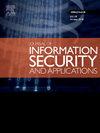Interpolation data hiding schemes based on center folding strategy and well-turned embedded positions
IF 3.7
2区 计算机科学
Q2 COMPUTER SCIENCE, INFORMATION SYSTEMS
Journal of Information Security and Applications
Pub Date : 2025-04-11
DOI:10.1016/j.jisa.2025.104055
引用次数: 0
Abstract
In the realm of steganography, payload and Peak Signal-to-Noise Ratio (PSNR) are pivotal metrics for evaluating the efficacy of data hiding techniques. While addressing security concerns, researchers have been striving to optimize one or both assessment indicators. As indicated by Lu et al. (2020), a reversible data hiding method can achieve high PSNR and payload capacity. This method employs a multi-layer center folding strategy for message concealment in interpolated images. In our study, the secret message is transformed into a code pair consisting of an index and code, utilizing Lu's scheme. Our proposed approach reorganizes these indexes and applies two distinct strategies, termed EnMCFS-8 and EnMCFS-9, aiming to refine data hiding quality through strategic embeddable position arrangements. In each 4 × 4 block of the cover image, EnMCFS-8 focuses on embedding eight indexes at the four locations, minimizing image distortion. Conversely, EnMCFS-9 distributes nine indexes across three diagonal locations to augment the hiding capacity. Each method serves specific objectives effectively. The experimental outcomes demonstrate the enhancements in hiding performance our proposed methods when compared to existing techniques.
基于中心折叠策略和良好翻转嵌入位置的插值数据隐藏方案
在隐写领域,有效载荷和峰值信噪比(PSNR)是评估数据隐藏技术有效性的关键指标。在解决安全问题的同时,研究人员一直在努力优化一个或两个评估指标。Lu et al.(2020)指出,可逆的数据隐藏方法可以实现高PSNR和有效载荷能力。该方法采用多层中心折叠策略对插值图像进行消息隐藏。在我们的研究中,利用Lu的方案将秘密消息转换成由索引和代码组成的码对。我们提出的方法重组了这些索引,并应用了两种不同的策略,称为EnMCFS-8和EnMCFS-9,旨在通过战略性嵌入位置安排来改进数据隐藏质量。在封面图像的每个4 × 4块中,EnMCFS-8重点在四个位置嵌入8个索引,最大限度地减少图像失真。相反,EnMCFS-9在三个对角线位置分配9个索引,以增加隐藏能力。每种方法都有效地服务于特定的目标。实验结果表明,与现有技术相比,我们提出的方法在隐藏性能方面有所提高。
本文章由计算机程序翻译,如有差异,请以英文原文为准。
求助全文
约1分钟内获得全文
求助全文
来源期刊

Journal of Information Security and Applications
Computer Science-Computer Networks and Communications
CiteScore
10.90
自引率
5.40%
发文量
206
审稿时长
56 days
期刊介绍:
Journal of Information Security and Applications (JISA) focuses on the original research and practice-driven applications with relevance to information security and applications. JISA provides a common linkage between a vibrant scientific and research community and industry professionals by offering a clear view on modern problems and challenges in information security, as well as identifying promising scientific and "best-practice" solutions. JISA issues offer a balance between original research work and innovative industrial approaches by internationally renowned information security experts and researchers.
 求助内容:
求助内容: 应助结果提醒方式:
应助结果提醒方式:


